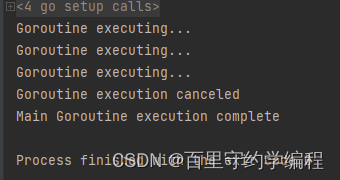在Go语言中,Goroutine是一种轻量级线程,它的退出机制对于并发编程至关重要。
函数或方法执行完毕
最常见的Goroutine退出方式是函数或方法执行完毕。当Goroutine中的函数或方法执行完毕时,该Goroutine会自动退出。
package main
import (
"fmt"
"time"
)
func main() {
go func() {
// Goroutine 中的函数执行完毕后自动退出
fmt.Println("Goroutine execution complete")
}()
// 主 Goroutine 继续执行其他任务
time.Sleep(time.Second)
fmt.Println("Main Goroutine execution complete")
}
在上面的示例中,我们创建了一个匿名的Goroutine,在其中打印一条消息,然后Goroutine执行完毕并自动退出。主Goroutine继续执行其他任务。
子协程返回
在Goroutine中,我们可以使用return语句显式地退出。当执行到return语句时,该Goroutine将会终止并返回,注:协程是没有返回值的,如果要返回,一般是用chan,往chan中写入,外部一般用waitgroup等待go执行完成后,读取chan的结果。
package main
import (
"fmt"
"time"
)
func main() {
go func() {
// Goroutine 中使用 return 语句显式退出
fmt.Println("Goroutine execution")
return
}()
// 主 Goroutine 继续执行其他任务
time.Sleep(time.Second)
fmt.Println("Main Goroutine execution complete")
}
在上面的示例中,我们创建了一个匿名的Goroutine,并在其中打印一条消息,然后使用return语句显式地退出Goroutine,这里演示的是函数末尾return,实际工作中很可能是中途需要return。
panic()与recover()
如果在Goroutine中发生了panic,默认情况下会终止当前程序的执行。我们可以在Goroutine中使用recover()函数来捕获并处理panic,以避免程序崩溃。
package main
import (
"fmt"
"time"
)
func main() {
go func() {
defer func() {
if err := recover(); err != nil {
// 在 Goroutine 中捕获并处理panic
fmt.Println("Recovered from panic:", err)
}
}()
// 引发恐慌
panic("Goroutine panic")
}()
// 主 Goroutine 继续执行其他任务
time.Sleep(time.Second)
fmt.Println("Main Goroutine execution complete")
}
在上面的示例中,我们创建了一个匿名的Goroutine,在其中使用panic()引发panic。然后使用defer和recover()捕获并处理panic,确保程序不会崩溃。
context的取消
Go语言的context包提供了一种机制来管理Goroutine的生命周期,包括取消正在运行的Goroutine。我们可以使用context.Context的cancel()方法来取消Goroutine的执行。一旦Goroutine接收到取消信号,它应该尽快退出。
package main
import (
"context"
"fmt"
"time"
)
func worker(ctx context.Context) {
for {
select {
case <-ctx.Done():
// 接收到取消信号后退出 Goroutine
fmt.Println("Goroutine execution canceled")
return
default:
// 执行正常任务
fmt.Println("Goroutine executing...")
time.Sleep(time.Second)
}
}
}
func main() {
ctx, cancel := context.WithCancel(context.Background())
go worker(ctx)
// 模拟取消任务
time.Sleep(3 * time.Second)
cancel()
// 主 Goroutine 继续执行其他任务
time.Sleep(time.Second)
fmt.Println("Main Goroutine execution complete")
}

在上面的示例中,我们创建了一个worker函数,在其中使用select和ctx.Done()判断是否接收到取消信号。当取消信号到达时,Goroutine会及时退出。






















 3961
3961

 被折叠的 条评论
为什么被折叠?
被折叠的 条评论
为什么被折叠?








